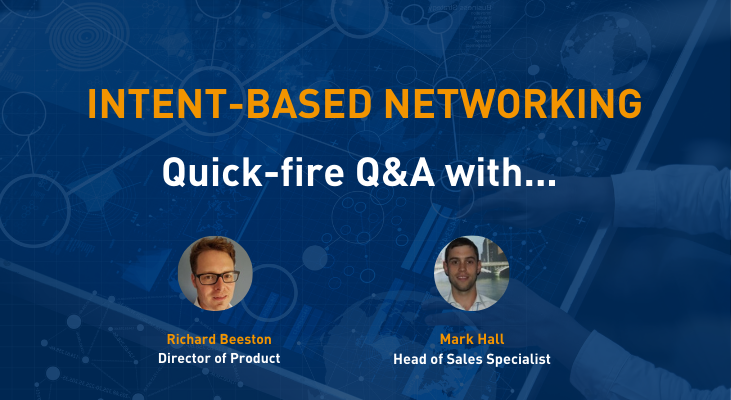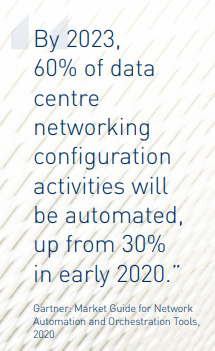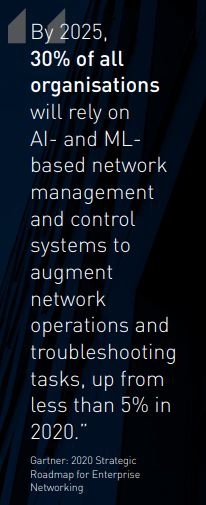
In this quick-fire Q&A, Daisy’s Connectivity experts Richard Beeston and Mark Hall give their view of what intent-based networking means for businesses going forward…
The way we work is changing, and network automation and remote management tools have become essential to effective operations. Intent-based networking (IBN), a term coined by Gartner, has been touted as the “next big thing” in networking to support changing business conditions.
Daisy’s Head of Product Richard Beeston (RB) and Head of Sales Specialist Mark Hall (MH) shed some light on using intent-based networking to your advantage now and into the future.
Intent-based networking (IBN) is a trend that has been gaining traction in the IT world in recent years, but what exactly is an intent-based network?
RB: Imagine a business network that automatically configures itself using your business intent; one that continually monitors and adjusts itself, and maintains its desired state. That is an intent-based network.
MH: Intent-based networking also refers to the use of AI, machine learning (ML), and network orchestration to automatically perform tasks. In a nutshell, it means IT teams won’t have to configure multiple devices to manage tasks manually. Instead, AI and ML capabilities will automatically administer commands based on the business’ intent.
What role do you think IBN plays for the workforce of the future?
MH: None of us really know what the future work environment will look like, but what we do know and have certainly seen over the past year, is that things can change very quickly. I am very confident that network automation will play an increasingly important role going forward, and automation is central to intent-based networking.
The infrastructure required to support distributed workers will only keep getting more complex and demanding, and so automation will be essential for businesses to keep pace with this evolving workplace. Those companies that had already embraced network automation gained a considerable advantage in terms of flexibility and speed over this past year as businesses worldwide had to support remote working almost overnight.
RB: This distributed workforce requirement aligns with the core automation and orchestration capabilities built into Cisco DNA Centre. While we don’t know the future’s exact shape, we know that Cisco DNA Centre’s capabilities support the agility, flexibility, and remote access that will help you adapt as we all move forward.
The automation provided by Cisco DNA Centre works because it uses business intent to define how a network should run. Then it defines policies and configurations to ensure the network operates as intended. Then – and here’s the real power – Cisco DNA Centre automatically pushes those policies and configurations throughout the network – even geographically-distributed networks.
Can Cisco DNA Centre’s automation capabilities help with the expanding threat surface created by more remote work environments?
RB: Cisco DNA Centre has security integrated into its automation capabilities. The highest-level threats on your network rise to the top of the list and it allows you to directly deploy the new patches to all affected devices.
For deployments, because of the automated nature of Cisco DNA deployments, the likelihood of manual error reduces significantly and therefore minimises vulnerabilities through incomplete or inaccurate deployments.
MH: Cisco DNA Centre also integrates with security solutions such as Cisco Stealthwatch and Cisco Umbrella, providing DNS protection, detection, and mitigation of threats – even when they are hidden in encrypted traffic. Rogue and adaptive wireless intrusion prevention is built right into the solution, meaning security and network management, both in greater demand in this new environment, can be more effectively managed through Cisco DNA Centre’s automation capabilities.
Will having an automated, intent-based network replace people in the future?
RB: Intent-based networking uses automation that simplifies things that humans do, including validation, and automates configurations tasks. But you still need humans to input data into the system. It shifts resources away from mundane networking tasks and means less reactive trouble tickets, but more proactive notifications to be tended to.
How does intent-based networking differ from traditional networking approaches?
MH: The traditional approach to managing networks is prescriptive, device-by-device and bottom-up. This approach makes network upgrades error-prone, time-consuming to manage, and resource-intensive, which slows down a business’s evolution. This approach is untenable because today’s networks are critical to a business, while network complexity continues to grow. Intent-based networking stops the complexity of manual operations that make the network difficult to operate, inefficient, and non-scalable, making the network easy to operate at scale.
RB: Cisco defines intent-based networking as “a network that continuously aligns to business intent.” It does this by capturing and translating your organisation’s intent for your network, then automating the intent, enforcing the intent, and assuring that your network is operating as intended. Cisco DNA realises the promise of intent-based networking.
Intent-based networking sounds a bit like software-defined networking (SDN), what’s the difference?
MH: Intent-based networking and software-defined networking are similar in many aspects. The goal of both approaches is to abstract the management from individual devices and align it closer to how a business needs to operate. Both technology approaches rely on a centralised controller to manage distributed devices on the network, as opposed to individually managing each device from its management console.
Where the two approaches differ is at the administrator level. SDN abstracts the management control from the devices, but it continues to have a device-centric view of the network. Commands in the SDN world are primarily about how devices should operate. The commands are abstracted at a higher level with intent-based networking, taking them from being device-centric to being business-centric.
RB: Cisco DNA allows IT teams to move beyond the automation-focused technologies of SDN. It uses a holistic approach to align networks with business intent. This approach combines automation with translation and policy, as well as assurance capabilities. Through this intent-based principle, Cisco DNA provides a way to make network services effective and agile as well as easy to use in the journey to digital transformation. It is an architecture that includes ready-to-use applications as well as easily-consumable APIs.
Why do you think Cisco DNA Centre is critical to the future of networking?
RB: Cisco set out to build the “network of the future” – a closed-loop system that’s self-learning, self-correcting and self-contained to deliver true intent-based networking. Cisco DNA Centre is a single touchpoint on top of the network that removes the complexity of the network underneath and structures processes to align with IT workflows. It provides an intuitive and simple overview of network health and clear drill-down menus for quickly identifying and solving issues. It is also the control point for all automation, orchestration, assurance, and analytics functions provided by Cisco DNA.
MH: Having your finger on the pulse of your network helps you assess its health and take corrective actions if necessary. With that accurate assessment, you can position the network for what the future might bring.
Will Cisco DNA Centre help accelerate an organisation’s digital transformation?
RB: Yes. By making networks more virtualised and programmable, Cisco DNA Centre allows quick changes to keep networks in sync with business process requirements, allowing the quick introduction, modification and deletion of business applications.
It also exposes APIs that enable integration with external applications. In using APIs, these applications can further automate networks to keep up with changing business needs. This is particularly useful to organisations that are transforming themselves and require their networks to be agile enough to support rapid changes.
If you have any questions about intent-based networking and what it can do for your organisation contact us on 0344 863 3000 or click here for more information.

